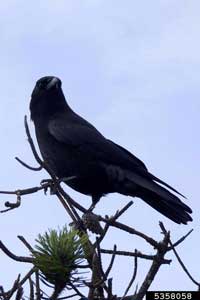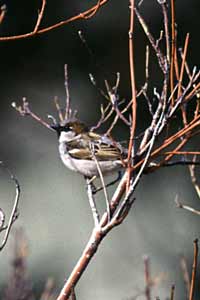Home → Pests → Other Critters → Starlings, Crows and Sparrows
Starlings, Crows and Sparrows
European Starlings
The European Starling is an exotic species that was introduced to North America in the 19th century. It is now one of the continents' most numberous songbirds. It is found across the United States and Canada, almost always near areas of human habitation and disturbance or areas with a reliable food source, such as near barns or granaries.
The European Starling is considered a pest for several reasons: it outcompetes native birds such as bluebirds and woodpeckers, taking their nesting cavities and destroying their eggs and young; it is aggressive at feeders, keeping smaller birds away and eating large amounts of birdseed; its enormous winter foraging flocks damage agricultural crops; and the large flocks leave large amounts of droppings around human habitations.
Common Crow
Crows are omnivorous, which means they like to eat all kinds of things: seeds, fruits, nuts, insects, mollusks, earthworms, eggs, nestlings, frogs, mice, garbage and dead things. They are very social, sometimes forming flocks in the millions. They thrive around people: in agricultural fields, lawns, parking lots, athletic fields, roadsides, towns, and city garbage dumps. They are sometimes considered pests because they gather in large numbers around people, making lots of noise, scattering garbage, and leaving large amounts of droppings. They are also an agricultural pest, particularly in orchards and cornfields.
House Sparrow
The familiar house sparrow is a chunky sparrow with a large head and short tail. It was introduced to this country from Europe to control caterpillars, and is in a different family from our native sparrows. It is now one of the most abundant songbirds on the continent.
House sparrows outcompete native bird species for food and nest sites, such as bluebirds and tree swallows. They form large flocks. They are sometimes considered pests because they displace native birds from bird boxes and at birdfeeders.

European starlings are chunky and blackbird-sized, but with short tails and long, slender beaks. At a distance, they look black. In summer they are purplish-green iridescent with yellow beaks; in fresh winter plumage they are brown, covered in brilliant white spots.
Click on images to view full-size
Identification and Control Information
- Vermont Wildlife Fact Sheet: Common Crow (PDF)—Vermont Fish & Wildlife
- Wildlife Damage Management Fact Sheet Series: Crows (PDF)—Cornell Cooperative Extension
- Fact Sheet: Urban Crows (PDF)—The Humane Society of the United States
- Wildlife in Connecticut: American Crow (PDF)—Connecticut Department of Environmental Protection
- Prevention and Control of Wildlife Damage: American Crows (PDF)—Internet Center for Wildlife Damage Management
- Controlling Nuisance Birds in New Mexico (with information about Starlings and Sparrows) [PDF]—New Mexico State University Cooperative Extension Service
- Living with Wildlife in Illinois: House Sparrow—University of Illinois Extension
- Prevention and Control of Wildlife Damage: House Sparrows (PDF)—Internet Center for Wildlife Damage Management
- European Starling and House Sparrow Control Fact Sheet (PDF)—Ellis Bird Farm, Canada
- Fact Sheet: The European Starling (PDF)—U.S. Department of Agriculture, Forest Service
- Prevention and Control of Wildlife Damage: European Starlings (PDF)—Internet Center for Wildlife Damage Management
More Information
- Preventing and Dealing with Nuisance Wildlife Encounters (PDF)—Ohio Department of Natural Resources
[Photos, left to right: Lee Karney, US Fish and Wildlife Service, Bugwood.org; Terry Spivey, USDA Forest Service, Bugwood.org; Terry L Spivey, Terry Spivey Photography, Bugwood.org]

